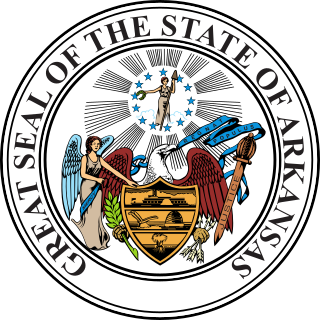Brown v. Board of Education of Topeka, 347 U.S. 483 (1954), was a landmark decision of the U.S. Supreme Court in which the Court ruled that U.S. state laws establishing racial segregation in public schools are unconstitutional, even if the segregated schools are otherwise equal in quality. The Court's decision partially overruled its 1896 decision Plessy v. Ferguson, declaring that the "separate but equal" notion was unconstitutional for American public schools and educational facilities. It paved the way for integration and was a major victory of the civil rights movement, and a model for many future impact litigation cases.

Daisy Bates was an American civil rights activist, publisher, journalist, and lecturer who played a leading role in the Little Rock Integration Crisis of 1957.

The NAACP Legal Defense and Educational Fund, Inc. is a leading United States civil rights organization and law firm based in New York City.
The civil rights movement (1896–1954) was a long, primarily nonviolent action to bring full civil rights and equality under the law to all Americans. The era has had a lasting impact on American society – in its tactics, the increased social and legal acceptance of civil rights, and in its exposure of the prevalence and cost of racism.
This is a timeline of African-American history, the part of history that deals with African Americans.
Ronald Norwood Davies was a United States District Judge of the United States District Court for the District of North Dakota. He is best known for his role in the Little Rock Integration Crisis in the fall of 1957. Davies ordered the desegregation of the previously all-white Little Rock Central High.
Cooper v. Aaron, 358 U.S. 1 (1958), was a landmark decision of the Supreme Court of the United States, which denied the Arkansas School Board the right to delay desegregation for 30 months. On September 12, 1958, the Warren Court handed down a per curiam decision which held that the states are bound by the Court's decisions and must enforce them even if the states disagree with them, which asserted judicial supremacy established in Marbury v. Madison. The decision in this case upheld the rulings in Brown v. Board of Education and Brown II which held that the doctrine of separate but equal was unconstitutional.

Alexander Pierre "A. P." Tureaud, Sr. was an African-American attorney who headed the legal team for the New Orleans chapter of the NAACP during the Civil Rights Movement. With the assistance of Thurgood Marshall and Robert Carter from the NAACP Legal Defense and Educational Fund, A. P. Tureaud filed the lawsuit that successfully ended the system of Jim Crow segregation in New Orleans. That case paved the way for integrating the first two elementary schools in the Deep South.
Green v. County School Board of New Kent County, 391 U.S. 430 (1968), was an important United States Supreme Court case involving school desegregation. Specifically, the Court dealt with the freedom of choice plans created to avoid compliance with the Supreme Court's mandate in Brown II in 1955. The Court held unanimously that New Kent County's freedom of choice plan did not adequately comply with the school board's responsibility to determine a system of admission to public schools on a non-racial basis. The Supreme Court mandated that the school board must formulate new plans and steps towards realistically converting to a desegregated system. Green v. County School Board of New Kent County was a follow up of Brown v. Board of Education.

The Little Rock Nine were a group of nine African American students enrolled in Little Rock Central High School in 1957. Their enrollment was followed by the Little Rock Crisis, in which the students were initially prevented from entering the racially segregated school by Orval Faubus, the Governor of Arkansas. They then attended after the intervention of President Dwight D. Eisenhower.

Black schools, also referred to as "colored" schools, were racially segregated schools in the United States that originated after the American Civil War and Reconstruction era. The phenomenon began in the late 1860s during Reconstruction era when Southern states under biracial Republican governments created public schools for the ex enslaved. They were typically segregated. After 1877, conservative whites took control across the South. They continued the black schools, but at a much lower funding rate than white schools.
The Mansfield school desegregation incident is a 1956 event in the Civil Rights Movement in Mansfield, Texas, a suburb of the Dallas–Fort Worth metroplex.

The National Association for the Advancement of Colored People (NAACP) is a civil rights organization in the United States, formed in 1909 as an interracial endeavor to advance justice for African Americans by a group including W. E. B. Du Bois, Mary White Ovington, Moorfield Storey and Ida B. Wells. Leaders of the organization include Thurgood Marshall and Roy Wilkins.
Hocutt v. Wilson, N.C. Super. Ct. (1933) (unreported), was the first attempt to desegregate higher education in the United States. It was initiated by two African American lawyers from Durham, North Carolina, Conrad O. Pearson and Cecil McCoy, with the support of the National Association for the Advancement of Colored People (NAACP). The case was ultimately dismissed for lack of standing, but it served as a test case for challenging the "separate but equal" doctrine in education and was a precursor to Brown v. Board of Education, 347 U.S. 483 (1954).
A.T. Walden was an American lawyer in Atlanta, Georgia who worked on many civil rights cases, campaigns for voter registration by African Americans, and building collaboration with the white power structure. In 1964 he was appointed by the mayor of Atlanta as a municipal judge, the first black judge to be appointed in the state of Georgia since Reconstruction.

School integration in the United States is the process of ending race-based segregation within American public and private schools. Racial segregation in schools existed throughout most of American history and remains an issue in contemporary education. During the Civil Rights Movement school integration became a priority, but since then de facto segregation has again become prevalent.
This is a timeline of the 1947 to 1968 civil rights movement in the United States, a nonviolent mid-20th century freedom movement to gain legal equality and the enforcement of constitutional rights for People of Color. The goals of the movement included securing equal protection under the law, ending legally-established racial discrimination, and gaining equal access to public facilities, education reform, fair housing, and the ability to vote.
Silas Herbert Hunt was a U.S. veteran of World War II who became the first African American student to enroll in a white Southern university since the Reconstruction era. He enrolled in the University of Arkansas School of Law on Feb. 2, 1948, breaking the color barrier in higher education and starting integration of colleges and universities in the South.
L. Clifford Davis is an attorney from Wilton, Arkansas, whose unsuccessful efforts for admission to the University of Arkansas Law School resulted in the eventual admission of African-American students to the school. He also served over thirty years as an attorney and judge, and assisted Thurgood Marshall in the case that became Brown v Board.
William Astor Kirk was a professor, author, a church lay leader and a social activist who worked for racial equality, gay rights, and to end segregation in the United Methodist Church. He also served in the Office of Economic Opportunity, after being appointed by President Lyndon Baines Johnson. A contemporary of Heman Sweatt he sought equal access to higher education at the University of Texas and eventually was the first African-American to be awarded a political science doctorate by UT.







